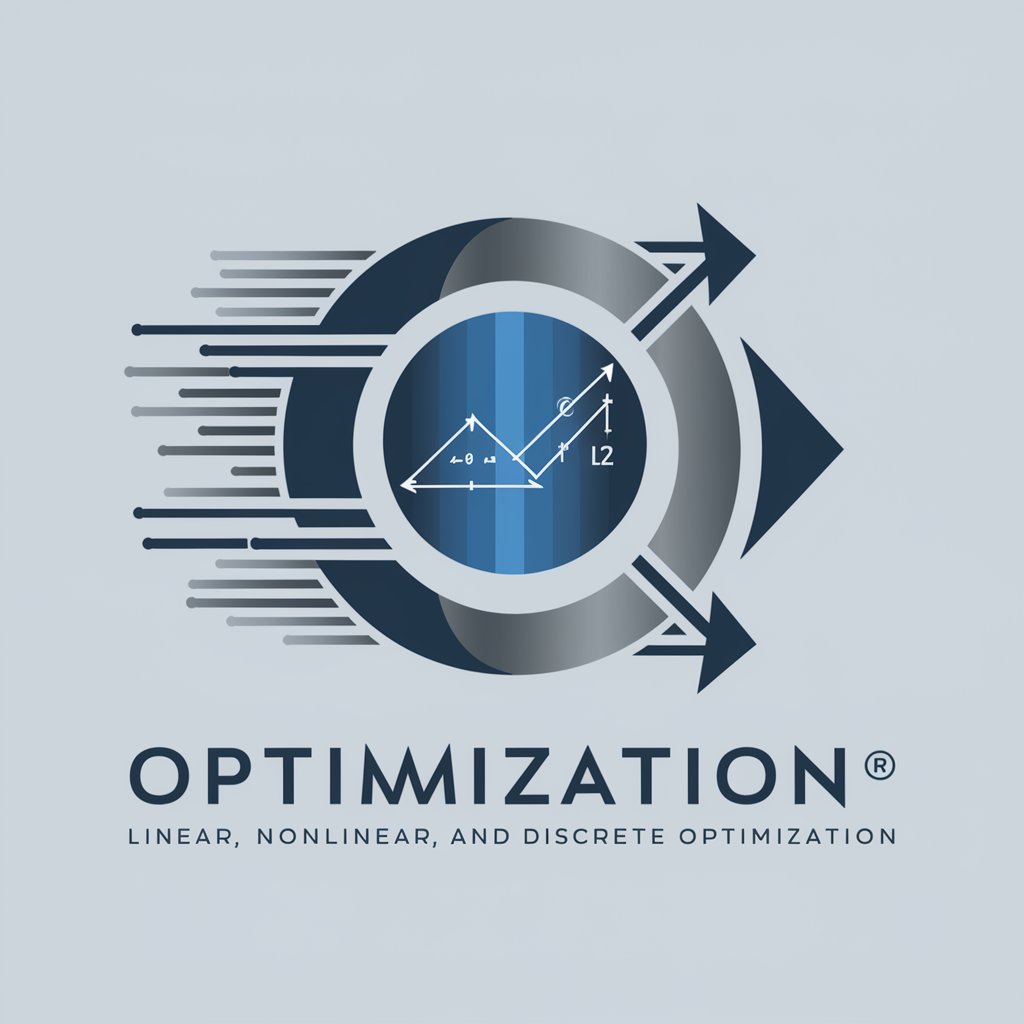Optimization - Efficient Problem-Solving

Welcome to Optimization, your partner in precision.
AI-Powered Optimization for Smarter Decisions
Optimize your business strategies with expert insights...
Discover the power of mathematical precision in decision-making...
Unlock your potential with advanced optimization techniques...
Transform complex problems into efficient solutions with Optimization...
Get Embed Code
Introduction to Optimization
Optimization is a branch of mathematics and operations research focusing on finding the best possible solution or outcome in various scenarios, often under certain constraints or limitations. Its primary function is to assist in decision-making processes by identifying the most efficient, cost-effective, or highest quality solution to a problem. Optimization can be applied to diverse fields such as engineering, economics, logistics, and artificial intelligence. An example of optimization in action is in logistics, where it can determine the most efficient route for delivering goods, considering factors like distance, traffic, and transportation costs. Another scenario is portfolio optimization in finance, where it helps in selecting the best combination of investments to maximize returns while minimizing risk. Powered by ChatGPT-4o。

Main Functions of Optimization
Linear Optimization
Example
Supply Chain Management
Scenario
Linear optimization is utilized in supply chain management to minimize costs or maximize efficiency in production and distribution processes. For instance, it helps in determining the optimal number of products to produce and the most efficient distribution routes.
Nonlinear Optimization
Example
Engineering Design
Scenario
In engineering design, nonlinear optimization plays a crucial role in optimizing the design of various components. For instance, it can be used to determine the optimal shape and material for a bridge, considering factors like strength, durability, and material costs.
Discrete Optimization
Example
Workforce Scheduling
Scenario
Discrete optimization is applied in workforce scheduling to assign shifts in a way that maximizes employee satisfaction while ensuring all shifts are covered. It involves making decisions from a finite set of options, such as assigning employees to shifts or tasks.
Ideal Users of Optimization Services
Business Analysts and Managers
Business analysts and managers use optimization to make informed decisions about resource allocation, budgeting, and strategic planning. Optimization tools help them in maximizing profits, reducing costs, and improving operational efficiency.
Logistics and Supply Chain Professionals
Professionals in logistics and supply chain management rely on optimization to enhance transportation routes, inventory management, and distribution strategies. This leads to cost savings, improved delivery times, and enhanced customer satisfaction.
Data Scientists and AI Researchers
Data scientists and AI researchers utilize optimization in machine learning algorithms, predictive modeling, and data analysis. It helps in fine-tuning models and algorithms for better accuracy and performance.

Guidelines for Using Optimization
Begin Your Journey
Start your optimization experience by visiting yeschat.ai to access a free trial immediately, bypassing the need for login or ChatGPT Plus subscription.
Identify Your Objective
Clarify your optimization goals, whether they're reducing costs, improving efficiency, or enhancing performance. Knowing your objective helps tailor the optimization process effectively.
Gather Data
Collect relevant data and inputs necessary for the optimization. This might include historical performance data, system constraints, and any other pertinent information.
Choose the Right Tool
Select an optimization tool or algorithm that best matches your problem's nature. This could range from linear programming for resource allocation to evolutionary algorithms for complex, nonlinear problems.
Analyze and Iterate
After applying your chosen optimization method, analyze the results for effectiveness. Iteratively refine your approach based on feedback and results to achieve optimal performance.
Try other advanced and practical GPTs
一店舗の飲食店で豊かな生活を
AI-Powered Restaurant Success

新宿行列グルメ探検隊
AI-powered culinary exploration tool

おすすめの飲み屋を教えてくれる人
Discover Local Izakayas with AI

ビジネスフレームワーク課題解決エージェント
AI-Powered Business Strategy Assistant

音楽から生成された絵を読解する
Discover Classical Music Through AI Art
楽天ROOMアイテム紹介アシスタント
Discover Products with AI Guidance

考研英语作文批改
Refine Your Academic Essays with AI

広報トレンド分析「トレンドナビ」📈🔥
AI-powered trend analysis for PR success

OFFLINE GTP
Smart Assistance, Anywhere

フラスコ君オンライン
Empower Your Goals with AI

핫플레이스 - MZ완전 저격 놀거리/맛집/술집/핫플
AI-powered hotspot finder for trendy outings.

말씀으로 한 걸음 더 들어간 나만의 묵상시간 갖기
AI-powered Bible study exploration.

Optimization Q&A
What is optimization and why is it important?
Optimization involves finding the most efficient solution to a problem from a set of available options. It's crucial for enhancing performance, reducing costs, and improving decision-making processes across various industries.
Can optimization be applied to all types of problems?
While optimization is versatile, its applicability depends on the problem's nature and complexity. It's widely used in operations research, engineering, economics, and many other fields, particularly where resource allocation is critical.
What are the common types of optimization problems?
Common types include linear programming for resource allocation, integer programming for decision-making in discrete scenarios, and nonlinear programming for problems with complex relationships.
How does machine learning relate to optimization?
Optimization is at the heart of machine learning, helping to minimize or maximize an objective function, such as loss in training a model, to improve algorithm predictions and decision-making.
What challenges are associated with optimization?
Challenges include dealing with the curse of dimensionality in large problem spaces, ensuring solution feasibility and robustness, and managing computational complexity in nonlinear or dynamic problems.
